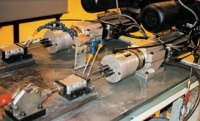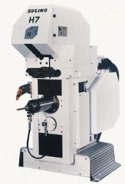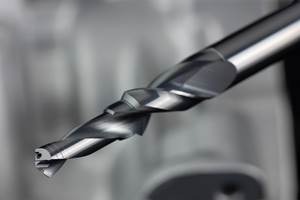Picking The Right Automatic Drilling Units
There are many ways to create holes in metal. Some machine tools, including machining centers and turning centers, drill holes as one of several operations performed. This article discusses different kinds of automatic drilling units, each of which is dedicated to making many holes - fast.
Share





www.mmsonline.com/suppliers/suginoDrilling, or hole making, is the most common metalworking operation in the world. A thousand millennia passed before someone developed a tool that could perforate bamboo or other hard reeds, and certainly thousands of additional millennia passed before someone was able to pierce stone or metallic materials to make a tool, musical instrument or weapon.
Hand-cranked drills gave way to overhead shafts for belt-driven drill units that gave way to pneumatic and electric drill machines, all hand-operated and controlled. The drill press became a standard tool in the shop; often, the shop would employ many people to attend these machines: drilling, tapping or providing whatever hole-finishing operation needed to meet the part specifications.
Where labor rates are low, specifications are loose and quality is flexible, many companies with burden rates at $15 to $25 an hour still operate in this manner. These companies will also integrate several presses into a gang-drill press station so that one worker can operate several drill presses sequentially. Consideration has to be given to the worker's output. While the worker is strong at the beginning of the shift, fatigue can seriously affect output and quality by the end of the shift, cause considerable breakage of drill bits and affect the rejection rate.
By the mid-20th century, an enterprising drill manufacturer saw the possibility of adapting the commonly used pneumatic drill to perform secondary repetitive operations on the workpiece, automatically. This was especially useful in longer production runs where the hole making was repetitive; the drill unit could be fixtured, the part clamped manually into position, and the drill unit activated.
The piece part would then be manually released and clamped into the next fixture for further processing. In time, mechanical stops were added to the drill unit to curtail the drilling operation to any set point in the workpiece.
Many of the inconsistencies due to human error and antiquated equipment were corrected with the new automated drill technology. Variable human factors were replaced with highly automated equipment that featured repetitious feed rate, depth repeatability, and longer tool life. The results were improved workpiece hole specifications with fewer rejects and greater productivity, and in most instances, with a lower labor burden rate.
All Pneumatic Drill Units
Because of the ready availability of compressed air, pneumatic drill units became the standard in volume production operations. Capable of practical speeds to 32,000 rpm, pneumatic drill units are used to drill small diameter holes in most every material, including steel, cast iron, aluminum, plastics, wood and other non-metallic materials where tolerances are not of critical importance.
Pneumatic drills are readily adaptable to small drill bits from 1/32-inch diameter up to approximately 1/2 inch where they become limited by their lack of torque. These units have a compact envelope, light weight and portability making them particularly suitable for use in tight spaces and in adverse environments such as explosive atmospheres.
Since air is the source of power, adjusting the air inlet according to the workload controls spindle rotation. Spindle travel and hole depth, fast forward, cutting, reverse and stop can all be controlled by adjustment screws and a control head which is built into the body of the pneumatic drill unit.
Pneumatic drill units can be fitted with multispindle drive heads having a capacity for two, three or four drills. Combining their compact and slim profile with their ability to accept a multispindle drill head makes them particularly suited to automated, multi-hole line operation.
Less expensive to purchase, and operating where there is an abundance of compressed air power, the pneumatic units can perform well and are economically justifiable within their limitations. The downside of pneumatic actuation is its limitations in drilling capacity, thrust and torque, which limits materials that can be effectively drilled. It also often creates a noise level in the 90 db range. With 50 percent more moving parts than electric units, pneumatic units are susceptible to higher maintenance cost, especially when operating with a contaminated air supply.
Electric Rotation Pneumatic Thrust Drill Units
Introduced into the American metalworking scene in the 1960s, the electric-pneumatic automated drill machines—electric spindle rotation and air thrust—proved to be an effective alternative to the pneumatic units. These drill units were initially more expensive to buy but users found they did not overly tax the available air supply, no matter how many units were brought on line. The most noticeable advantage of the electric-pneumatic drill units—over pneumatic-only units—is the expansion of the drill diameter capacity, allowing larger hole-making and job finishing possibilities.
Available with spindle motors starting at 1/8 hp and with spindle speeds ranging up to 12,000 rpm, these drill units can be supplied with motors up to 10 hp and larger, delivering over 2,000 pounds of thrust for drilling holes up to 2 inches in a wide variety of applications, such as steel bridge structures, truck and railroad car frames and high-rise building girders.
While the larger units are used for drilling metals, the smaller-size units are often used to drill everything from wood furniture to titanium golf club heads, epoxy on glass circuit boards, asbestos-based sound insulation material, and glass used in automotive windshields and windows.
Among design features inherent in the all-electric, mechanical-feed drill units is an AC servomotor that turns a ballscrew to deliver infinitely variable feed rates. AC servo spindle motors can be supplied to deliver infinitely variable rpm, independent of the feed rate, permitting the fine tuning of feed and speed to produce the exact chip form and hole quality. An important feature is the NC system that holds up to 100 programs of operating patterns and cutting feed rates for easy setup and operation, including a second reference point—an important feature to reduce cycle time. The operator simply programs the parameters of the drill, tap and finishing functions and the unit will do the rest, including count the number of parts going through the cycle and automatically switching to a second set of operating parameters for a similar part but with slightly different hole specifications.
Variation requirements are performed by programming and without mechanical changes. In today's just-in-time manufacturing process, this capability to change over and set up for a family of parts is a critical requirement for production.
Because of their reliability and consistent performance, the all-electric, mechanical-feed NC drill units are commonly used in transfer lines and dial-index machines and integrated into manufacturing cells and systems with other sophisticated machining equipment.
Cutting Tool Considerations
The tooling used with any of the automated drill units, as well as any of the manual drill machines, affects the quality of the hole-making/finishing operation. The point geometry, material, coating, and a number of other variables can have a significant impact on tool life, productivity, and the finish and quality of the drilled hole.
A recent advancement that created a significant impact on drilling tool technology was the development of the `S' shape cutting edge for the twist drill. The chisel edge of the conventionally ground twist drill was replaced with an `S' shape grind that allows the drill to cut material at its center-most point, rather than push the material. This development drastically reduces the thrust forces and can eliminate the need for drill guide bushings in some applications.
It is important for manufacturing personnel to know the latest cutting tool developments and understand their impact toward the overall success of the drilling application.
Further Advancements In Automated Drilling
From hand-held drill tools, to manually operated gang-drill press operations, to automated operations working as stand-alone machines or in transfer lines or other setups, automated hole-making equipment is a flexible method of drilling and tapping. Automatic drill units have been installed directly on lasers and flame cutting equipment, turret-punch presses and other machinery and make use of the machine's CNC control for secondary hole-making operations.
Recent technology advancements in automated drilling machines have bypassed shortcomings of previous "one-step" drill and tap designs that can effectively use the combination Drap drill/tap tool and Dream drill/ream combination tools. For example, the Sugino Duomech drill/tap machine, and others like it, can eliminate one complete setup and reduce throughput time by as much as 75 percent over traditional sequential operations.
In the past decade, many manufacturers have engineered drill/tap CNC machining centers to perform hole-making operations. These multi-axis machines with unique drill/tap and milling capabilities easily replaced larger machining centers whose hourly burden rate can range from $150 to $300 per hour. One study reported that 70 percent of all machining center operations consisted of hole making. Many shops have come to realize it is less economical to use 7.5 to 30 hp machining centers that spend almost three quarters of their in-cut time producing holes smaller than 5/8-inch diameter. The birth of the 2 hp to 5 hp drill/tap centers sprung from this realization. By utilizing small drill/tap machining centers, manufacturers can free their higher horsepower, more expensive machining centers to take the heavy milling cuts and machine the larger holes that they were designed to produce.
These small drill/tap machining centers offer an affordable means of drilling and tapping holes with CNC technology. There are currently drilling/tapping centers using a rotary turret to hold ten or more spindles or automatic tool changer-type centers with the capacity to hold 22 tools to perform a variety of hole-making and hole-finishing operations. Some drilling/tapping centers are equipped with dual spindles that can double production and feature an automatic turntable to facilitate loading and unloading of parts, further boosting production.
Drilling/tapping centers are designed to work as stand-alone machines, or they can be adapted to work within a manufacturing cell or system.
Recently, several machine tool manufacturers have introduced three-axis modular drill/tap units complete with CNC controls, all electricals. They are line ready modules designed to operate in dial-index, in-line transfer systems and for flexible machining cells. Fully equipped, tested and ready to operate, these modular units can perform at the same levels as their drill/tapping center counterparts.
About the author: Jon Wolfe is executive vice president of Sugino Corporation (Schaumburg, Illinois).
Related Content
Darex Adds End Mill Attachment to Drill Sharpener
This LEX600 end mill attachment enables users to sharpen the primary and secondary grind on the tips of two-, three- or four-fluted end mills up to 5/8".
Read MoreMeasuring Torque, Thrust Force for Smart Drilling Operations
To monitor drilling operations for smart manufacturing solutions, torque and thrust force can be measured.
Read MoreKennametal's Expanded Tooling Portfolio Improves Performance
The company has launch eight new products that expand on and support existing platforms across multiple applications.
Read MoreEmuge-Franken's New Drill Geometry Optimizes Chipbreaking
PunchDrill features patent-pending geometry with a chipbreaker that produces short chips to control machining forces.
Read MoreRead Next
5 Rules of Thumb for Buying CNC Machine Tools
Use these tips to carefully plan your machine tool purchases and to avoid regretting your decision later.
Read MoreSetting Up the Building Blocks for a Digital Factory
Woodward Inc. spent over a year developing an API to connect machines to its digital factory. Caron Engineering’s MiConnect has cut most of this process while also granting the shop greater access to machine information.
Read MoreBuilding Out a Foundation for Student Machinists
Autodesk and Haas have teamed up to produce an introductory course for students that covers the basics of CAD, CAM and CNC while providing them with a portfolio part.
Read More






















.jpg;maxWidth=300;quality=90)











